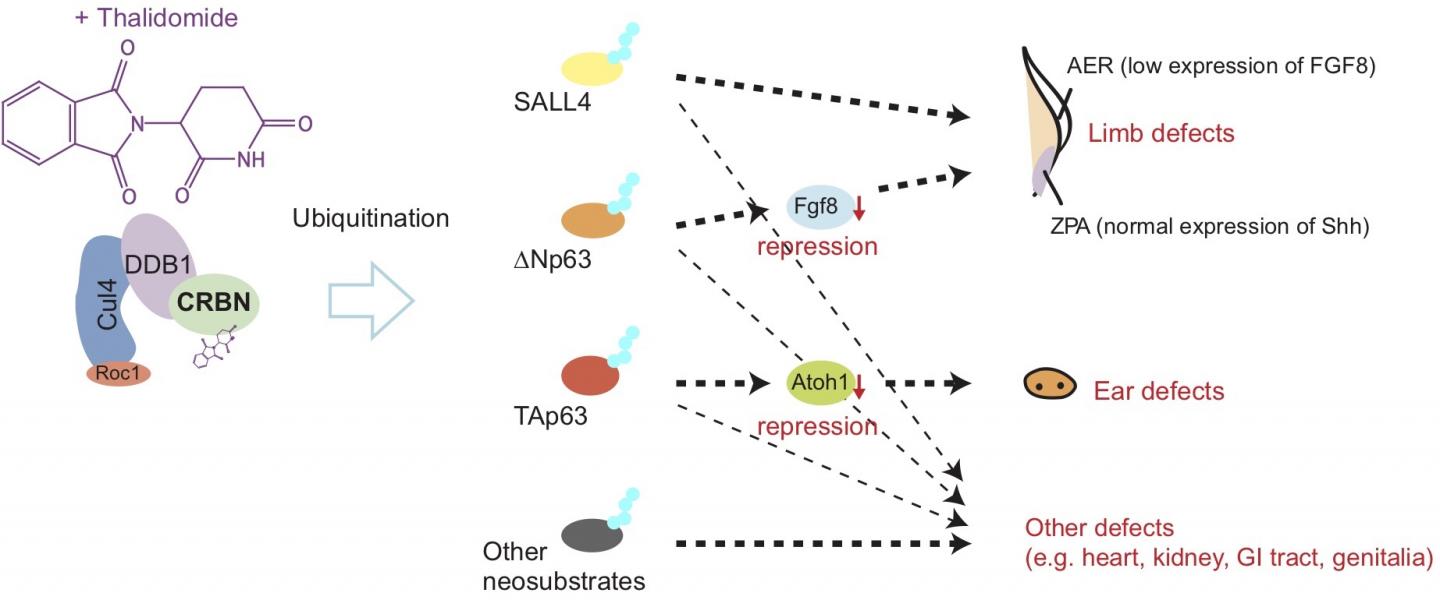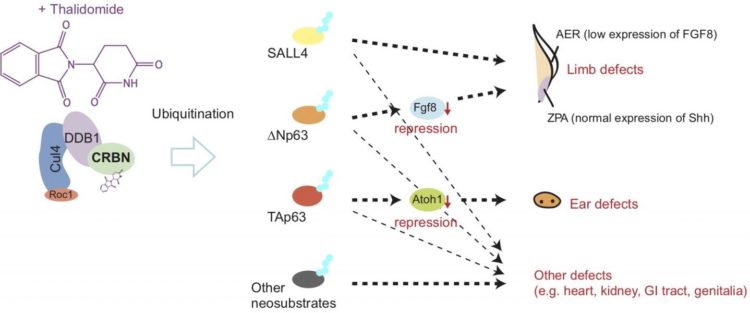Molecular basis of drug’s effects on limb and ear development revealed

Credit: Nature Chemical Biology
An international study co-authored by researchers at Tokyo Institute of technology (Tokyo Tech) and Tokyo Medical University has unveiled a detailed view of how thalidomide, one of the most notorious drugs ever developed, causes abnormalities in limb and ear development. The findings may contribute to the re-emergence of safe, or non-teratogenic, thalidomide-derived drugs as a treatment for cancer and inflammatory diseases.
Researchers in Japan and Italy have deepened understanding of the way in which thalidomide causes developmental abnormalities at the molecular level.
Thalidomide has a reputation as one of the most potent substances that can cause birth defects. Originally used in the late 1950s as a treatment for morning sickness, evidence in the early 1960s linked thalidomide to abnormalities including shortened limbs and defective organs, which led to its ban around the world.
Remarkably, based on subsequent findings that highlighted thalidomide’s anti-inflammatory and other beneficial properties, the drug has become a major example of one that can be repurposed to treat conditions such as leprosy and multiple myeloma, a type of blood cancer.
“The thalidomide tragedy is not an open-and-shut case in medical history, but is ongoing,” explains biochemist Yuki Yamaguchi of Tokyo Tech, “as new thalidomide babies have been born after its re-approval in around 2000.”
“But we now know that thalidomide and its derivative drugs are highly effective and are associated with few side-effects, except for the teratogenic effects on the fetus, unlike many other conventional anti-cancer agents,” he points out. “Therefore, teratogenicity remains a big hurdle for wider application of these promising drugs.”
To investigate the mechanisms behind thalidomide activity in more detail, Yamaguchi collaborated with Hiroshi Handa of Tokyo Medical University, Luisa Guerrini of Universita degli Studi di Milano, Italy, and others to conduct developmental studies using zebrafish as a model organism. This collaboration set out to explore Guerrini’s hunch that the p63 family of proteins might be critically involved. In 2010, a team led by Handa and Yamaguchi achieved a breakthrough by identifying cereblon as a key protein through which thalidomide initiates its adverse or teratogenic effects. (See Molecular Basis of Brain Dysfunction and Embryo Malformation Associated with Thalidomide.)
Now, the latest study published in Nature Chemical Biology shows that after binding to cereblon, thalidomide causes damage to fins (corresponding to limbs) and to otic vesicles (corresponding to ears) by inducing the breakdown of two types of p63 proteins. Specifically, the study suggests that the breakdown of ΔNp63α results in limb defects, while that of TAp63α leads to ear defects, as shown in Figure 1.
Understanding how cereblon works to mediate the effects of thalidomide could transform the way drugs are developed — moving away from serendipitous discovery and towards rational molecular design. “The change would be like a shift from looking for a needle in a haystack to carving a needle out of bone,” Yamaguchi notes.
“It’s likely that we will see the development of new thalidomide-based drugs without teratogenic effects in the near future,” he says.
###
Authors:
Shimizu[1,5], Kazuhide Asakawa[1,5], Yuki
Yamaguchi[3], Takumi Ito[1,4,5], Luisa Guerrini[2] and Hiroshi Handa[1,5]
Affiliations
[1] Department of Nanoparticle Translational Research, Tokyo Medical University
[2] Department of Biosciences, Universita degli Studi di Milano
[3] School of Life Science and Technology, Tokyo Institute of Technology
[4] PRESTO, JST
[5] Present Address: Department of Chemical Biology, Tokyo Medical University
Related links:
Department of Chemical Biology, Handa Lab http://www.
Molecular Basis of Brain Dysfunction and Embryo Malformation Associated with Thalidomide https:/
Yamaguchi Lab
http://yamaguchi.
About Tokyo Medical University:
Established in 1916, Tokyo Medical University can now boast more than 100 years of tradition. The spirit of this school is enshrined in the words “Self-reliance and Self-study”. This describes the type of medical professional to which we aspire: one resolved to undertake honest self-appraisal, think for themselves, and ceaselessly pursue their studies. With this in mind, our mission is to foster excellence in medical professionals as partners in health in line with our school motto of “Justice, Friendship, and Service”.
About Tokyo Institute of Technology:
Tokyo Tech stands at the forefront of research and higher education as the leading university for science and technology in Japan. Tokyo Tech researchers excel in fields ranging from materials science to biology, computer science, and physics. Founded in 1881, Tokyo Tech hosts over 10,000 undergraduate and graduate students per year, who develop into scientific leaders and some of the most sought-after engineers in industry. Embodying the Japanese philosophy of “monotsukuri,” meaning “technical ingenuity and innovation,” the Tokyo Tech community strives to contribute to society through high-impact research.
https:/
Media Contact
Emiko Kawaguchi
[email protected]
81-357-342-975
Original Source
https:/
Related Journal Article
http://dx.





